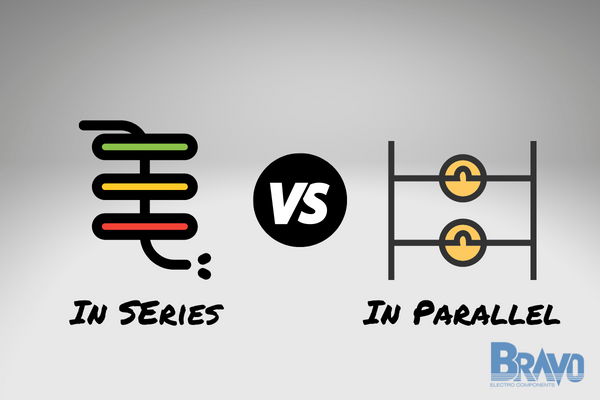
When you need to connect multiple power supplies together to reach your desired power output, you'll have two approaches you can take: connecting power supplies in parallel or connecting power supplies in series.
Each method has its pros and cons, which is why we’re going to break down the nuances between connecting power supply in series vs parallel to leave you feeling confident in your next steps.
Connecting power supplies in series will increase the output voltage, whereas connecting those same power supplies in parallel would raise the output current. So which approach makes the most sense for your application?
| Power Supply in Series | Power Supply in Parallel |
|---|---|
| Voltage increases – The total output voltage is the sum of all power supplies in series, but the current remains the same as the lowest-rated unit. | Current increases – The total current output is the sum of all power supplies in parallel, while voltage remains the same as the lowest-rated unit. |
| High efficiency – Ideal for applications needing high voltage without increasing current, such as industrial systems and test equipment. | Less efficient – Without proper current-sharing circuits, imbalances can cause inefficiencies and overload certain power supplies. |
| No need for current sharing circuits – Since each PSU carries the same current, there's no need for active current balancing. | Requires current-sharing circuits – Specialized circuitry is needed to ensure even current distribution between supplies. |
| Less sensitive to conductor design – Minor differences in wiring or conductor resistance have minimal impact. | Highly sensitive to conductor design – Differences in resistance or cable length can cause uneven current distribution, affecting performance. |
| Compatible with different voltage-rated PSUs – As long as all power supplies have the same current rating, they can be mixed. | Requires similar power supplies – All units should have identical voltage and current ratings for optimal performance. |
| Best for high-voltage applications – Used in scenarios where voltage stacking is needed, such as high-voltage research equipment, industrial automation, and laser systems. | Best for high-current applications – Commonly used in systems needing more power output without increasing voltage, such as battery charging systems and motor-driven machinery. |
That chart should give you a good grasp of which approach best suits your application. But, we’ll elaborate below and provide more context. Remember, you can always get in touch with our team at Bravo Electro for a personalized recommendation as well!
Why Connect Power Supplies Together?
The first, and most obvious reason to connect power supplies together, is to generate more power output than what a single power supply can provide. Getting a more powerful power supply unit isn't always feasible, after all.
Let's say you're running a large server farm with 50 servers. Each server requires 100 watts of power. A single 500-watt power supply would be maxed out and your servers would be at risk of crashing.
In this case, you would need to either find a very powerful single power supply (which can be expensive) or connect multiple lower-powered supplies in parallel (more on that later).
Another common reason people need to connect multiple power supplies together is redundancy and the peace of mind it provides. Connecting power supplies in parallel is essentially creating a backup system - if one power supply fails, the others can pick up the slack and keep your devices running.
This is critical for applications where any downtime simply isn't an option, like hospital equipment or data center servers. The only question is, does it make more sense to connect power supply in series vs parallel?
What Does Connecting Power Supplies in Series Mean?
When you connect power supplies in series, you're essentially connecting them end-to-end, like links in a chain. This doubles system voltage output while halving the current.
Say you have two 12-volt power supplies with a maximum current output of three amps. If you were to connect these power supplies in series, your new system would have a 24-volt output - but maintain just three amps of current.
Advantages
This approach is most commonly used when you need to increase the voltage output of your system without increasing its overall power (power supply wattage).
It’s also used in space-limited applications since it requires fewer cables than connecting power supplies in parallel. You’ll enjoy near-perfect utilization of power delivery between the connections, too.
Plus, there’s no need for configuration or sharing circuits with a greater tolerance for variation in the application. It's simply a more versatile approach since power supplies needn't be identical.
Drawbacks
First and foremost, the output must be capable of tolerating voltage offsets. In some cases, the output voltages of ground-referenced power supplies cannot be stacked on the outputs of other supplies.
You also should know that the output's voltage can be reversed in certain situations. While this is easily remedied with a few design improvements, it does create more work.
What Does Connecting Power Supplies in Parallel Mean?
Connecting power supplies in parallel is essentially connecting the positive terminal of one supply to the positive terminal of the other, and doing the same for the negative terminals.
This has the effect of doubling your system's current output while keeping the voltage constant. If we were to connect the same two 12v power supplies from our previous example in parallel, we would end up with a 12-volt system with six amps of current.
Advantages
You can increase the current output of your system without increasing its overall power. Parallel connections are also a good choice if you need to connect a large number of devices, as each power supply can handle more devices when they're connected in parallel.
Drawbacks
You’ll need to take careful steps to ensure power supply efficiency with this topology. It works best with power supplies that feature internal circuits - otherwise, external methods must be used.
Be aware that this will compromise efficiency and in turn cost more in the long run. It's also worth noting that for best results, the power supplies connected in parallel should be identical.
Connecting Power Supply in Series vs Parallel: Which is the Right Approach?
Just like with choosing between an isolated vs non-isolated power supply or a switching vs linear power supply, only you can determine which is best for you between series vs parallel power supply connections.
Connecting power supplies in series is best when you need to increase voltage without affecting current, while connecting them in parallel is best when you need to increase current without affecting voltage.
It’s really that simple - but you should account for space constraints and the number of devices you need to connect as well.
- Voltage Output: If you need to increase the voltage output of your system, connecting power supplies in series is the way to go. This approach will double your system's voltage while halving its current.
- Current Output: If you need to increase the current output of your system, connecting power supplies in parallel is the best approach. This will double your system's current while keeping the voltage constant.
- Space Constraints: Connecting power supplies in series require fewer cables than connecting them in parallel, so it's a good choice if space is limited.
- Number of Devices: If you need to connect a large number of devices, connecting power supplies in parallel is the best approach. This is because each power supply can handle more devices when they're connected in parallel.
In general, connecting power supplies in series grants greater versatility and is easier to set up than connecting power supplies in parallel. But, now that you know the pros and cons of each approach, you can make an informed decision about which one is right for your needs. Here is a quick summary of each approach below:
Connect power supplies in series if you want:
- To increase voltage without affecting current
- Simpler cable management
- More versatility since it can be designed with differing power supplies.
Connect power supplies in parallel if you want:
- To increase current without affecting the voltage
- To connect more devices in a parallel configuration.
- Each power supply to handle more devices
- To install identical power supplies.
Again, a customer service representative at Bravo Electro can not only help you choose between connecting power supply in series vs parallel but also offer recommendations on the specific PSUs you should use.
From 24v DC power supplies to 48v power supplies, enclosed power supplies, open frame power supplies, modular power supplies, DIN rail power supplies, and much, much more - explore our full catalog or get in touch today!
Final Thoughts on the Power Supply in Series vs Parallel Debate
That concludes our breakdown of the difference between connecting a power supply in series vs parallel. So, which of these is the right approach for your needs?
It depends on what you need to increase - voltage or current - and also how many devices you need to connect. If space is constrained, then series might be the way to go. But if you have a lot of devices that need power, connecting power supplies in parallel is probably your best bet.
Still not sure which approach is right for you? Bravo Electro is happy to help - just give us a call or send us an email, and we'll guide you through the process. We have engineers on staff to help you design and implement custom power configurations - so don't hesitate to reach out!









